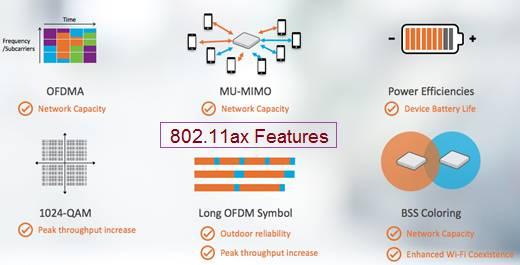WiFi 6 (802.11ax): Advantages and Disadvantages
This page explores the advantages and disadvantages of WiFi 6, also known as 802.11ax. It details the benefits and drawbacks of this latest WiFi standard.
What is WiFi 6 (802.11ax)?
Introduction:
- IEEE 802.11ax is the 6th generation of WiFi technology, hence the name WiFi 6.
- Due to its high efficiency, it’s also known as HEW (High Efficiency WLAN).
- It was developed to overcome the limitations of 802.11ac, such as contention-based uplink access.
- 802.11ax offers improved efficiency, network capacity, performance, and user experience with reduced latency.

Image Courtesy: Ruckus Networks
Features of WiFi 6 (IEEE 802.11ax)
The following are key features of WiFi 6:
- Higher modulation scheme: 1024-QAM
- More OFDM subcarriers in a symbol (long OFDM symbol)
- Multiplexing users with MU-MIMO in both uplink and downlink
- Beamforming and OFDMA techniques
- 8 simultaneous MU-MIMO streams
- Uplink scheduling without contention
- BSS color codes
- Use of both 2.4 GHz and 5 GHz bands
WiFi 6 (802.11ax) physical layer supports bandwidth options like 20 MHz, 40 MHz, 80 MHz, 80+80 MHz, and 160 MHz. It supports FFT sizes e.g. 256, 512, 1024 and 2048. The subcarrier spacing is 78.125KHz. The symbol duration is 12.8 µs + 0.8/1.6/3.2 µs CP.
Benefits and Advantages of WiFi 6
The following are the key benefits and advantages of WiFi 6 (802.11ax) technology:
- Higher Data Rates: Developed to deliver 40% higher peak data rates using a single client device. Average throughput per user is significantly improved (at least 4x) in dense environments.
- Increased Network Efficiency: Offers a fourfold increase in network efficiency compared to 802.11ac.
- Backward Compatibility: Compatible with older standards, 802.11n and 802.11ac devices.
- OFDMA: Utilizes OFDMA, allowing multiple users to transmit simultaneously. OFDMA-based scheduling reduces overhead and latency.
- Improved Battery Life: Enhanced battery life for 802.11ax client devices with TWT (Target Wake Time). TWT allows devices to sleep and wake up at scheduled times, saving power.
- Co-Channel Interference Mitigation: BSS color codes mitigate co-channel interference, helping 11ax stations identify transmissions from other networks.
- Robust Signaling: Offers robust, high-efficiency signaling for better operation at significantly lower RSSI.
- Indoor and Outdoor Performance: Performs well in both indoor and outdoor environments, using longer symbol duration and cyclic prefix (CP) outdoors and shorter CP indoors.
Drawbacks and Disadvantages of WiFi 6
The following are the drawbacks and disadvantages of WiFi 6 (802.11ax) technology:
- Narrower Subcarrier Spacing: OFDM subcarrier spacing is narrower at 78.125 KHz. This requires good phase noise oscillators and highly linear RF front ends.
- Tight EVM Specification: Due to the use of 1024-QAM for higher data rates, the EVM (Error Vector Magnitude) specification is very tight.
- Frequency Synchronization: Tight frequency synchronization and clock offset correction are required for optimal performance.
- Frame Timing: WiFi 6 stations must maintain frame timing based on their clocks, as transmissions must adhere to trigger frames and scheduling.
- Adoption Hurdles: While no longer in draft, wider adoption and deployment may still take time.
 RF
RF



